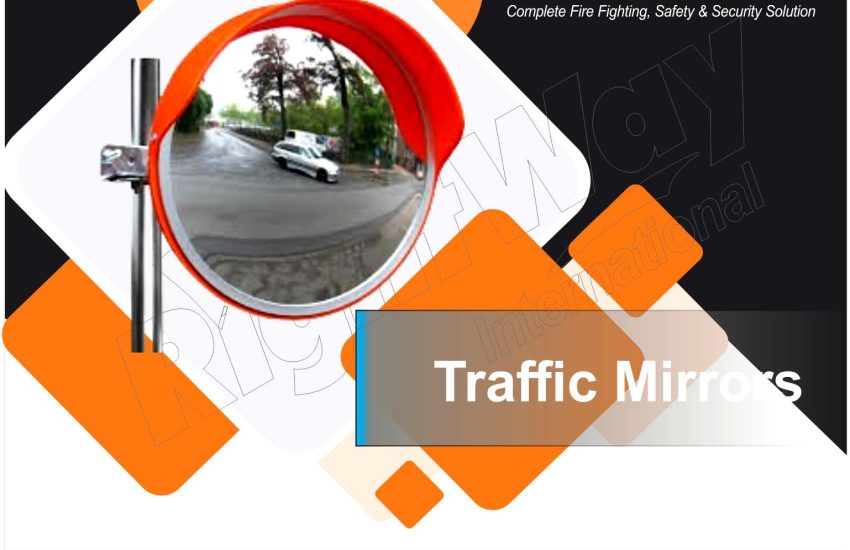Traffic mirrors, also known as road safety mirrors or convex mirrors, are critical tools used to improve visibility and safety at various points on the road. By allowing drivers to see around blind spots, navigate tricky intersections, and avoid collisions, these mirrors play a crucial role in enhancing road safety. This article explores the purpose, types, benefits, and best practices related to traffic mirrors.
Purpose of Traffic Mirrors
- Improving Visibility
- Blind Spots: Traffic mirrors help drivers see around blind spots, such as curves, intersections, and driveways, where visibility might be limited. This allows for better decision-making and safer maneuvering.
- Intersection Safety: They provide a clear view of approaching traffic at intersections or crosswalks, reducing the risk of collisions and improving overall traffic flow.
- Enhancing Safety
- Accident Prevention: By providing additional visibility, traffic mirrors help prevent accidents caused by limited sightlines or obstructed views, particularly in high-traffic or complex areas.
- Pedestrian Protection: They help drivers see pedestrians, cyclists, and other road users, ensuring safer interactions and reducing the likelihood of accidents.
- Traffic Management
- Guiding Traffic: Traffic mirrors can be used to guide traffic through complex road layouts or to enhance visibility for drivers entering or exiting driveways and parking lots.
- Emergency Situations: They assist emergency vehicles by providing a clearer view of traffic conditions, helping them navigate through congested areas more effectively.
Types of Traffic Mirrors
- Convex Traffic Mirrors
- Wide-Angle View: Convex mirrors are designed with a curved surface that provides a wide-angle view of the surrounding area, allowing drivers to see more of their environment.
- Durability: Typically made from high-quality materials such as acrylic or polycarbonate, these mirrors are durable and resistant to impact and weather conditions.
- Rectangular Traffic Mirrors
- Extended Coverage: Rectangular mirrors offer extended coverage and are often used in situations where a broader field of view is needed, such as at large intersections or wide driveways.
- Customization: These mirrors can be customized in size and shape to suit specific traffic management needs.
- Safety Mirrors
- High-Visibility Frames: Equipped with high-visibility frames and reflective surfaces, safety mirrors enhance visibility and ensure they are easily noticeable in various lighting conditions.
- Enhanced Features: Some models include additional features such as anti-glare coatings or illumination to improve visibility during low-light conditions.
- Roadside Mirrors
- Pole-Mounted: Roadside mirrors are mounted on poles or posts and are commonly used at intersections, sharp turns, and other critical points where enhanced visibility is required.
- Adjustable Angles: Many roadside mirrors are adjustable, allowing for customization of the viewing angle to best suit the specific location.
Benefits of Traffic Mirrors
- Increased Safety
- Accident Reduction: By providing better visibility around blind spots and at intersections, traffic mirrors help reduce the likelihood of accidents and collisions.
- Enhanced Awareness: They improve driver awareness of their surroundings, including pedestrians and other vehicles, contributing to a safer road environment.
- Improved Traffic Flow
- Clearer Navigation: Traffic mirrors assist in smoother navigation through complex or congested areas, reducing hesitation and potential for traffic bottlenecks.
- Efficient Maneuvering: By improving visibility, they allow for more efficient and confident maneuvering, particularly in challenging driving conditions.
- Cost-Effective Solution
- Low Maintenance: Traffic mirrors generally require minimal maintenance compared to other safety devices and provide a cost-effective solution for enhancing road safety.
- Durable Materials: Made from durable materials, they offer long-lasting performance with minimal need for replacement or repairs.
Best Practices for Using Traffic Mirror
- Proper Placement
- Strategic Locations: Install mirrors at key locations such as intersections, blind spots, and driveways to maximize their effectiveness in improving visibility.
- Optimal Height and Angle: Ensure mirrors are positioned at the correct height and angle to provide the best view for drivers. Adjust as needed based on traffic patterns and road conditions.
- Regular Maintenance
- Clean and Inspect: Regularly clean mirrors to remove dirt, debris, or grime that can obstruct visibility. Inspect for any damage and repair or replace mirrors as needed.
- Check Adjustments: Periodically check and adjust the angle and position of mirrors to ensure they continue to provide optimal visibility.
- Adhere to Regulations
- Follow Guidelines: Ensure that the installation and use of traffic mirrors comply with local and national traffic safety regulations and guidelines.
- Safety Standards: Use mirrors that meet safety standards for durability, visibility, and performance to ensure effectiveness and compliance.
Conclusion
Traffic mirror are vital tools for enhancing visibility and safety on the road. By improving sightlines around blind spots, intersections, and driveways, they help prevent accidents and facilitate smoother traffic flow. Understanding the different types of traffic mirrors and following best practices for their placement and maintenance can significantly contribute to a safer and more efficient road environment.


